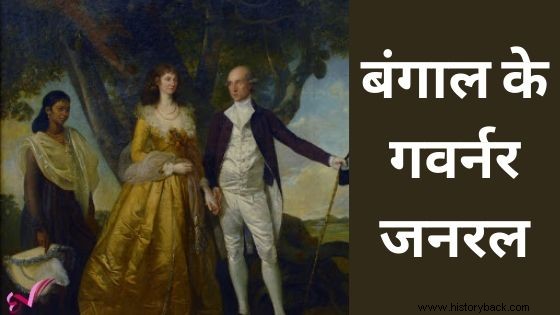Today in this article we will tell you India History in Hindi – Governor General of Bengal Telling about.
Questions coming in RRB and SSC exams
Governor General of Bengal

Robert Clive (1757- 60 AD and 1765- 67 AD)
Q. Who had arranged Daith rule in Bengal?
Ans. Robert Clive
Q. By which treaty did Clive take the Mughal Emperor Shah Alam-II under the protection of the Company by the Company?
Ans. Second Treaty of Allahabad (1765 AD)
Warren Hastings (1774- 85 AD)
Q. Who was the extension governor general under the company in India?
Ans. Warren Hastings
Q. Where did the Hastings move the state treasury from Moshirabad?
Ans. In Calcutta
Q. Who established the first madrasa in Calcutta for the development of Muslim education?
Ans. In 1781 AD, Hesitigs
Q. Who founded the Sanskrit school in Banaras?
Ans. Jonathan Duncan in 1792 AD
Q. Who provided shelter to William Wilkins, the English translator of the Gita?
Ans. Hasitges
Q. Who founded The Asiatic Society of Bengal?
Ans. 1784 AD Sir William Jones
Q. Who published the first newspaper of India, The Bengal Gazette?
Ans. 1780 AD Mayb James Augustus Hickey
Q. When was the High Court at Calcutta established?
Ans. Under the Regulating Act in 1774 AD
Q. When was the Treaty of Salbai?
Ans. In 1782 AD
Q. When was the Treaty of Mangalore signed?
Ans. In 1784 AD
Q. In whose era was the Board of Revenue established?
Ans. of Hesitgs
Q. Why did Warren Hastings resign?
Ans. Against Pitt's India Act (1784 AD)
Sir John Macpherson (1785-86 AD)
Q. Who was appointed as the Provisional Governor General after the Hastings?
Ans. To Sir John Macpherson
Lord Kovalis (1786- 93 and 1805 AD)
Q. In whose time all the rights of the district were given in the hands of the Collector?
Ans. Cornwallis's
Q. Who started the touring courts?
Ans. Cornwallis's
Q. Who built the famous Cornwallis Code?
Ans. Cornwallis in 1793 AD
Q. On what principle was the famous Cornwallis Code based?
Ans. On the principle of separation of powers
Q. Who banned the personal trading of the employees of the company?
Ans. Cornwallis's
Q. Who introduced the system of Permanent Settlement?
Ans. Cornwallis in 1793 AD
Q. Who planned the Permanent Settlement?
Ans. John Shore
Q. Who is considered the father of civil service in India?
Ans. To Cornwallis
Sir John Shore (1793-98 AD)
Q. Who adopted the policy of non-intervention?
Ans. Sir John Shore
Lord Wellesley (1798- 80 AD)
Q. Who introduced the system of subsidiary alliance?
Ans. Lord Wellesley
Q. Who used the Subsidiary Treaty in India before Wellesley?
Ans. French Governor Dupleix
Q. Who founded the Fort William College in Calcutta?
Ans. Wellesley
Q. Who used to call himself the Lion of Bengal?
Ans. Wellesley
Sir George Warlon (1805- 1807 AD)
Q. The Sepoy Mutiny in Vellore is an important event of whose period?
Ans. Sir George Barlow's
Lord Minto-I (1807- 1813 AD)
Q. In whose time the Charter Act was passed?
Ans. Lord Minto-I
Lord Hastings (1813–1823 AD)
Q. Between whom was the Treaty of Sangoli signed?
Ans. Between the British and the Gorkhas in 1816 AD
Q. In whose time the Pindaris were suppressed?
Ans. of Lord Hastings
Q. The power of the Marathas was finally destroyed?
Ans. Lord Hastings
Q. Who enacted the Tenancy Act or Tenancy Act?
Ans. In 1822 AD Hesitigs
Lord Amherst (1823–1828 AD)
Q. When did the first Anglo-Burma war take place?
Ans. Lord Amherst
Q. Between whom was the Treaty of Yandbu signed?
Ans. Between Burma and the British in 1826 AD
Q. When did the military mutiny of Barrackpore take place?
Ans. In 1824 AD
Today in this article we have given you India History in Hindi – Governor General of Bengal, First Governor General of Bengal, Chief Governor General, Governor General and Viceroy of India, Governor General Trick If you want any other information related to this, then you can ask by commenting in the comment box.
